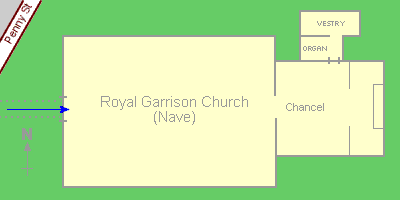
Visiting the Royal Garrison Church
This listed Ancient Monument is open from from April to September (Mon-Fri between 11am and 4pm).
Car Parking
Parking on streets adjacent to the church is permitted, though residents parking schemes operate in some areas.
Friends of the Royal Garrison Church
For bookings and information about the church phone the Secretary, Peter Richmond, on 023 9282 3973 or e-mail
Click for street map
There are nearly 300 memorials associated with this church. They have been listed below according to their current location or, where it is known, their original location. That this is sometimes unclear is due to the fact that so many are physically missing from the church, having been removed following the bombing of the church in 1941. Further problems have been caused by the decision not to replace the church roof (see below) which has led to considerable erosion of the plaques. Fortunately, just after the restoration of the church, in 1873, the then Chaplain, Archdeacon H.P. Wright wrote a guide to the church which contained transcripts of all the memorials in existence at the time. We have made extensive use of this guide as well as a ledger that remains in the church to this day which provides additional evidence.
The memorials have also been listed alphabetically on an A-Z page.
The Nave Wall Plaques
(Anti-clockwise from the West Door)
The Nave Window Plaques
(Anti-clockwise from the West Door. All of these plaques have been removed from their original locations. Some are at the English Heritage store, some are lost and one (*) is still in the church)
In The Chancel
(Anti-clockwise from the West Door)
The Chancel Windows
(Anti-clockwise from the West end. All the original windows were lost in 1941. Follow the links below for the dedications before and after the loss)
|
Lieut-Gen. The Hon. Henry Edward Butler |
The Choir Stall Plaques
The Nave Bench Plaques
After the restoration of the church in 1868, some 57 benches were installed in the Nave for the congregation. The 1873 Guide lists all 57 (without transcriptions), but a separate (undated) handwritten ledger in the church lists 51 (with transcriptions). Most of the benches were adorned by a memorial plaque, approximately 19cms wide and 12 cms high, fixed on the side facing the central aisle. In January 1941, the Luftwaffe dropped several bombs on the nave area of the church. Many of the benches and plaques were lost in this action. The church ledger mentioned above contains a diagram showing where each of the plaques/benches was. The memorials below are listed in the same order, starting from west to east on the north side of the aisle (Nos. 128-152) followed by east to west on the south side (Nos. 153-178). The remaining 6 names are listed in the 1873 Guide but do not appear in the ledger - the transcriptions have therefore been lost. In 2008, two of these plaques were returned to the church, for details see the plaque to Major Breton
Behind the Organ
The Royal Garrison Church has undergone many changes during it's existence one of which was the installation of an organ. This was placed in the transept in such a way as to completely obscure several memorials. Fortunately, the transcriptions of those memorials, being in existence in 1873, were included in the Guide to the Church. The following memorials are believed to exist, but are hidden by the organ.
At Fort Brockhurst - Formerly in the Nave
In addition to those memorials recorded above, there are others that have from time to time been removed from the church by English Heritage and taken to their store at Fort Brockhurst in Gosport. Most of them were probably removed because of the damage they sustained during the bombing in 1941 when many of the stone memorials shattered and the metal ones partially melted. The Friends of the Church obtained permission to record the contents of the store. The results of this work is published below. Some inscriptions have been checked against, or completed from, the 1873 Guide to the Garrison Church. The Guide has also provided valuable evidence as to the original location of many of the memorials; e.g. Nos. 199 & 200 were on or close to the pulpit; approximate positions within the nave have been determined for the rest.
The Lost Memorials
Thanks to the 1873 Guide to the Church we can tell which memorials were present at that time but which for various reasons do not appear to have survived. Further information has also been obtained from the Record Office at the Museum of Army Chaplaincy which includes several memorials not recorded elsewhere. Unfortunately there is often no more than a surname in these records and so we have not listed them here. Those for which we have useful information, are listed below.
At The Royal Army Chaplains Department Record Office/Museum
After the bombing of the church in 1941 all of the valuable silver plate was removed for safe keeping. This consisted principally of the Queen Anne plate and the Cornwallis plate. These items are now housed at the RAChD, Amport House, near Andover, Hampshire.
The Cornwallis Plate
The Queen Anne Plate
Late Additions
The Church Graveyard
The graveyard is situated to the west and north of the church. Its modern appearance is of a well ordered resting place, even though most of the inscriptions on the headstones are now illegible. It is doubtful however, if the stones lie anywhere near their original positions. When Archdeacon Wright came to the church he reported that the graveyard had "... been neglected for years. Brick graves abounded; some tottering some in ruins; lofty iron railings covered with rust and sadly mutilated....... headstones were everywhere and in every direction, deep hollows and irregular mounds alternated....". This is patently not what the visitor will see today, where those gravestones that remain are laid in, for the most part, orderly rows, with the headstones inset horizontally into the grass.
We are fortunate in that the Church Ledger, mentioned earlier, records details of all the stones that were extant at the time of writing. Although we have no definite date for the ledger, an official stamp at the front records the date as 28th February 1889 and the very first entries are an alphabetical list of the gravestone names. Against the record of one of the stones is the note "This stone was found about a foot underground in 1887, when I was clearing the graveyard. (signed) J.J. Francis, Sexton and Verger". It seems therefore that a considerable amount of activity must have taken place in the graveyard between the time that Archdeacon Wright instigated a clean-up operation around 1870.
A further point worthy of note is that the majority of the graves record deaths in the first half of the 19th century; the latest being in 1854. There are about 7 or 8 which date to before the turn of the century with the earliest recorded as 1770. Given that this area had been in use for some 700 years as a hospice and chapel it seems highly unlikely that no one would have considered burying anyone there until 1770. We are left then with an incomplete history of the burials, but that doesn't mean we can't extract some interesting information.
Firstly we note that several of the persons commemorated on memorials within the church have gravestones outside it. Where we are confident that memorial and gravestone refer to the same person we have recorded both inscriptions on the relevant page noted above.
Secondly, there appears to be a blurring of definition between 'memorial' and 'gravestone'. The Garrison Church is not unique in this feature but it does mean we can add a number of further memorials that only appear in the graveyard.
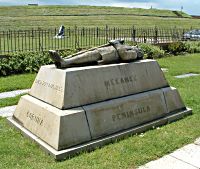
Sir Charles Napier Tomb
Thirdly, and perhaps we shouldn't be too surprised at this, but there is a very high proportion of children buried in the graveyard. Apart from the obvious implications of a high infant mortality rate at the time, we are unsure whether this has any greater significance.
The most visually appealing grave relic is that for Sir Charles Napier; a tomb like edifice that stands adjacent to the path in front of the west door. Whilst one might rightly expect such an imposing structure to stand over the mortal remains of the great soldier it does not in fact do so. It had long been known that this tomb had been moved to accommodate the building of an extra bay to the nave at the time of the restoration in 1873. The original position was not known until 2004 when a plan showing the location of Napier's burial place was discovered at the Army Chaplains Museum in Amport. It transpired that it occupied much the same position in relation to the earlier west door as the tomb does to the current door. It is not yet known whether the body lies in a simple grave or in a crypt.
Transcriptions of the gravestone texts.





'Following detailed consideration by English Heritage and the University of Portsmouth it has been concluded that, if a roof were to be provided (to the Nave), the rate of deterioration of the stone would probably be increased. Owing to its location, it is inevitable that the now exposed stonework will have absorbed considerable amounts of salt solution and, if it were enclosed, the trapped water would dry out causing the salt to crystallise on and under the surface of the stone resulting in accelerated deterioration. It is therefore not intended to replace the main roof so that the Nave will remain as a partial ruin as a memorial to all those service men who gave their lives for their country, in particular in the second world war when the church was damaged.' Quoted from the Guide to the Royal Garrison Church.
History of the Royal Garrison Church
Download a history of the church in MS Word Format (77Kb)
For a copy of Archdeacon Wright's book "History of the Domus Dei" go to the Internet Archive
Images of the Church
Reproduced below are five images of the Church and the Governor's House. The upper three are engravings from the Guide to the Church and are dated 1716 - c1820. They are reproduced by kind permission of the Friends of the Garrison Church. The lower two are undated but must have been drawn before 1826 when the Governor's House was demolished. The drawing on the right is alleged to have been made by Admiral Spencer Smyth who would have had to be sitting on top of the Semaphore Tower, which in turn was on top of the Square Tower, to have obtained this angle.
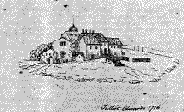 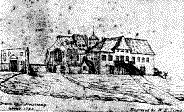 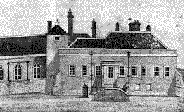
|
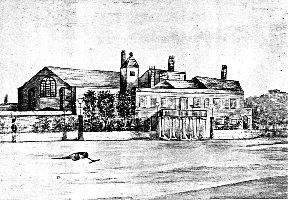 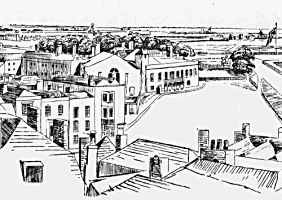 |
